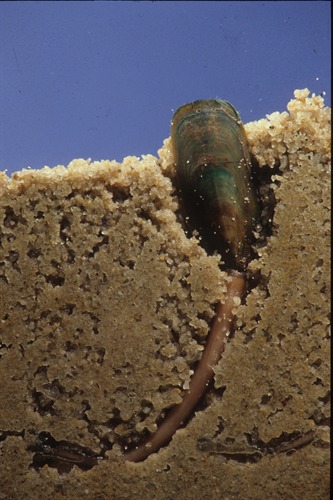
Back
Lingula unguis Linnaeus 1758
| Family Name: | Lingulidae |
| Taxonomic Group: | Invertebrates (Lamp Shell) |
| Common Name: | Lamp Shell |
Name
Ecology, Habitat & Location
| Ecological Notes | Lives in vertical burrows up to 35cm deep in mud or muddy sand from mid-tide level down to the sublittoral zone. When the tide is in, the shell gapes to expose spirally arranged arms of the ciliary lophophore, the feeding organ. |
|---|---|
| Habitats | Marine, Mudflats, Sandy Shore |
| Distribution | In Singapore this, the only species of its group here, used to be very abundant in sheltered localities along the coast of the western Johor Straits. Nowadays it is extremely hard to find it in its former sites. |
Conservation
| Trends & Threats | It seems likely that pollution of the western straits may have contributed to the decline of this formerly abundant animal. With closure of the causeway, the upper reach of the straits is almost stagnant. Increasing organic pollution makes the deeper waters almost anoxic and from time to time conditions bringing such water to the surface result in massive fish mortality. Increased boat activity has led to occasional oil spills fouling the mudflats. |
|---|---|
| Scientific Interest & Potential Value | Lingula is said to be the oldest living genus of animals, almost unchanged in 500 million years. |
| Conservation Notes | Once the remaining habitat where the species can still be found in good numbers is identified, the area should be set aside for conservation. |
Status
| Singapore Red Data Book Status | Endangered (EN) [2008] |
|---|
Photos
References
| References | Davison, G.W.H., Ng, P.K.L. & Ho, H.C (Eds.). 2008. The Singapore Red Data Book (2nd Edition). Singapore: Nature Society (Singapore). 285pp |
|---|
